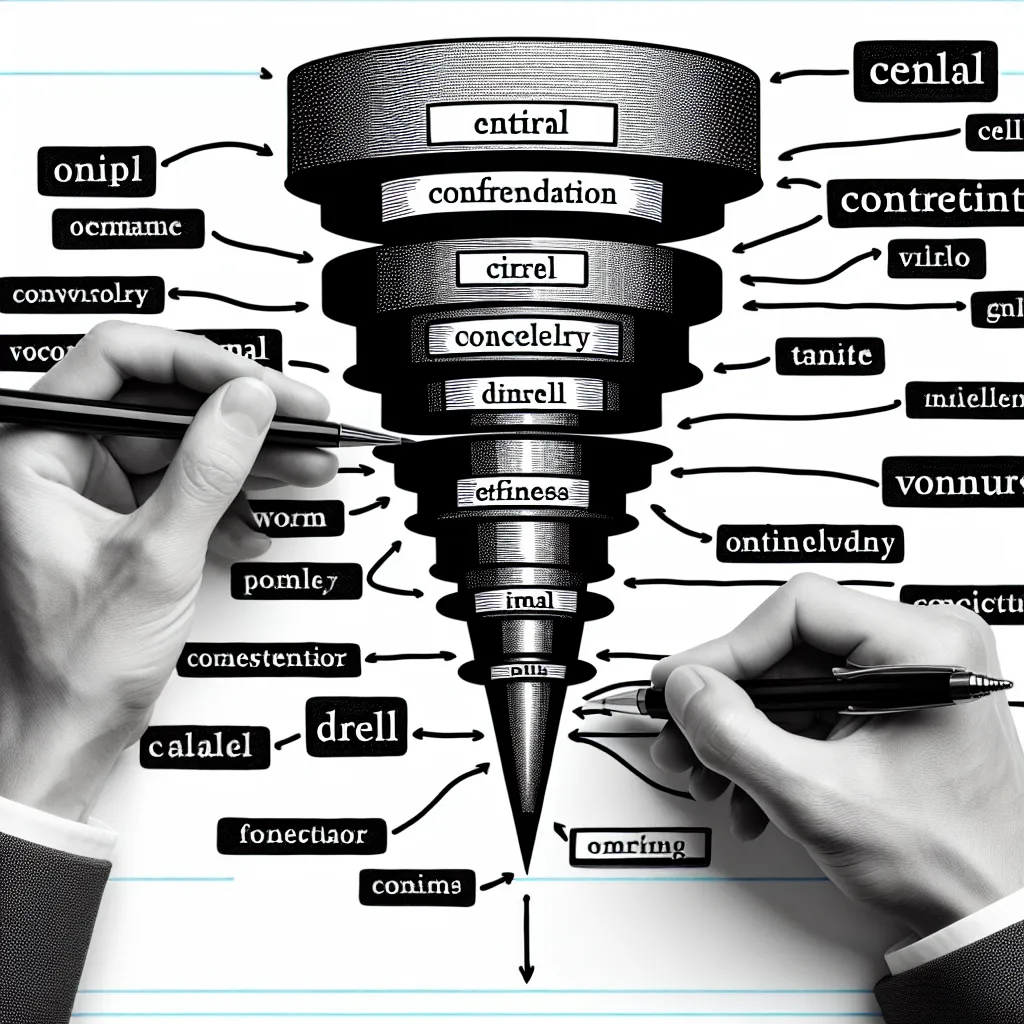Cone drills are an effective technique for expanding and reinforcing vocabulary, especially useful for IELTS preparation. Let’s explore this method in depth and see how it can boost your language skills.
What are Cone Drills?
Cone drills, in the context of language learning, are exercises that start with a central word or concept and branch out to related terms, creating a cone-like structure of vocabulary. This method helps learners to build connections between words, enhancing both retention and usage.

Definition and Origin
- Definition: A vocabulary learning technique that expands from a central word to related terms.
- Part of Speech: Noun phrase
- Pronunciation: /koʊn drɪlz/
Context and Usage
Cone drills are particularly useful in IELTS preparation, as they help candidates expand their vocabulary range and improve their ability to use words accurately in various contexts. Let’s look at some examples:
- Central word: Environment
- Branch 1: Pollution (air pollution, water pollution, noise pollution)
- Branch 2: Conservation (wildlife conservation, energy conservation)
- Branch 3: Sustainability (renewable energy, eco-friendly practices)
In this example, environment serves as the central concept, branching out to related terms that are frequently used in IELTS speaking and writing tasks about environmental issues.
- Central word: Technology
- Branch 1: Artificial Intelligence (machine learning, neural networks)
- Branch 2: Cybersecurity (data protection, encryption)
- Branch 3: Social Media (online platforms, digital marketing)
This cone drill on technology showcases how learners can expand their vocabulary in a topic that often appears in IELTS reading and listening tests.
- Central word: Education
- Branch 1: Learning methods (e-learning, blended learning, experiential learning)
- Branch 2: Assessment (standardized tests, continuous assessment, peer evaluation)
- Branch 3: Curriculum (core subjects, electives, extracurricular activities)
This structure helps IELTS candidates to discuss education systems comprehensively, a common topic in speaking and writing tasks.
Analyzing Cone Drills
Structure and Benefits
Cone drills are structured to facilitate:
- Word associations: By linking related terms, learners create mental connections that aid recall.
- Contextual understanding: Words are learned in relation to each other, improving usage in context.
- Vocabulary expansion: Starting from familiar terms, learners gradually incorporate new, related vocabulary.
Synonyms and Antonyms
While cone drills focus on related terms, incorporating synonyms and antonyms can further enhance vocabulary:
- Synonyms for “cone drill”: Vocabulary mapping, word association exercise, lexical expansion technique
- Related concepts: Mind mapping, semantic networks, word clustering
Memorization Techniques
Mind Mapping
Create visual representations of cone drills to enhance memory:
Storytelling
Craft narratives using words from your cone drill. For example, using the “Environment” cone:
“As an environmental activist, Sarah focused on conservation efforts. She campaigned against air pollution and promoted renewable energy sources to ensure sustainability for future generations.”
Practical Applications for IELTS
Speaking Practice
Use cone drills to prepare for IELTS Speaking tasks:
- Choose a central word related to common IELTS topics (e.g., “Urbanization”).
- Create branches with related terms (e.g., “population density”, “infrastructure”, “gentrification”).
- Practice speaking about the topic using terms from your cone drill.
Writing Enhancement
For IELTS Writing tasks:
- Use cone drills to brainstorm ideas for essays.
- Incorporate terms from different branches to demonstrate vocabulary range.
- Practice paraphrasing using synonyms and related terms from your cone drill.
Reading and Listening Preparation
Cone drills can improve comprehension:
- Create cone drills for common IELTS themes (e.g., “Climate Change”, “Globalization”).
- When encountering these themes in practice tests, you’ll have a broader understanding of related vocabulary.
Exercise: Creating Your Own Cone Drill
Try creating a cone drill for the word “Globalization”:
- Start with “Globalization” at the center.
- Create branches for aspects like “Economy”, “Culture”, and “Technology”.
- Add related terms to each branch.
- Use this cone drill to write a short paragraph about globalization’s impact.
Conclusion
Cone drills are a powerful tool for IELTS preparation, enabling candidates to expand their vocabulary systematically and contextually. By regularly practicing this technique, you can enhance your lexical resource, improve your ability to discuss complex topics, and boost your overall performance in the IELTS test.
Remember, consistent practice is key. Start creating cone drills for various IELTS topics and incorporate them into your daily study routine. Share your experiences with cone drills in the comments below, and don’t hesitate to ask questions about this vocabulary enhancement technique!